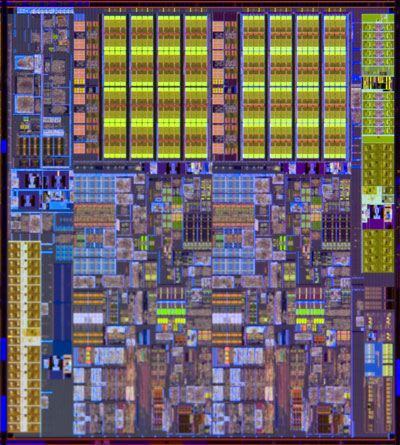|
A nanometer is so small that it takes a billion of them to make a meter. A billion is a huge number. A stack of a billion sheets of paper would be 100 km high. If you could walk a billion steps, you would go around the earth 20 times.
The original transistor built by Bell Labs in 1947 was large enough that it was pieced together by hand. By contrast, more than 60 million 32nm transistors could fit onto the head of a pin. (A pin head is about 1.5 mm in diameter)
More than 4 million 32nm transistors could fit in the period at the end of this sentence. (A period is estimated to be 1/10 square millimeter in area)
A 32nm transistor contains gates that are so small, you could fit 3,000 of them across the width of a human hair. (A human hair is about 90 microns in diameter; a 32nm transistor gate is about 30nm long)
If a typical house shrunk as transistors have, you would not be able to see a house without a microscope. To see a 32nm feature with the naked eye, you would have to enlarge a chip to be larger than a house. (The smallest feature visible to the naked eye is 40 microns)
Compared to Intel's first microprocessor, the 4004, introduced in 1971, a 32nm CPU runs over 4000 times as fast and each transistor uses about 4000 times less energy. The price per transistor has dropped by a factor of about 100,000.
A 32nm transistor can switch on and off over 300 billion times in one second. It would take you 4000 years to flick a light switch on and off that many times. (Assumes a person can flick a light switch on and off 150 times per minute)
Intel has shipped over 200 million CPUs using high-k/metal-gate transistors – the kind used in 32nm processors -- since the technology was first put into production in November 2007. This translates to over 50,000,000,000,000,000 (50 quadrillion) transistors, or the equivalent of over 7 million transistors for every man, woman and child on earth.
The "World's Fastest Man," Usain Bolt would have to take 3,125,000,000 steps in the 100 meter dash if his stride length was 32nm.
You could sharpen an image 28% faster on Adobe Photoshop (compared to 45nm).
The all new Intel® Core™ processor family is 4,767 times faster compared to Intel's first processor, the Intel 4004.
If the pace of innovation in space travel had increased at the pace of Moore's Law since 1971, you would now be able to travel at the speed of light, 671 million miles per hour.
|

